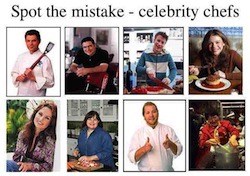I never was a disciple of the Jamie Oliver ministry, or any other celebrity chef that knows shit about food safety (which is most of them, see the abstract from our 2004 paper, below).
Alexis Carey of The Courier Mail writes that when Jamie Oliver first landed on our TV screens back in 1999, he soon won over millions of fans thanks to his delicious recipes and cheeky, boyish charm.
 Countless television appearances and cooking programs quickly followed his original series, The Naked Chef, along with cookbooks, advertising deals, charity campaigns and even his own chain of restaurants.
Countless television appearances and cooking programs quickly followed his original series, The Naked Chef, along with cookbooks, advertising deals, charity campaigns and even his own chain of restaurants.
But today, a string of controversies coupled with multimillion-dollar losses has meant the shine has well and truly started to come off the 43-year-old Brit.
So how did it all go so wrong for one of the world’s best-loved celebrity chefs?
According to Aussie public relations expert Catriona Pollard, Oliver’s downfall was caused by a series of classic PR blunders including overexposure, a disconnect between his actions and his personal brand and a failure to address a number of controversies head-on.
Over the years, the father-of-five built a restaurant empire under the Jamie Oliver Restaurant Group, starting with the launch of Jamie’s Italian in 2008, followed by the Recipease cooking school and deli chain in 2009 and barbecue chain Barbecoa in 2011.
But in September 2017, Oliver was forced to inject $22.7 million of his own cash into Jamie’s Italian to save it from collapsing.
All Recipease outlets were closed by late 2015 and last February Barbecoa Ltd went into administration.
Ms Pollard said one possible reason behind those failures was the mismatch between Oliver’s “average Joe” identity and the up-market feel of his eateries.
The collapse of Oliver’s restaurants have affected his own personal brand.
“You can buy one of his books for $20, or watch his TV show for free. But a lot of his restaurants sold expensive meals … which didn’t really stack up for people,” she told news.com.au.
She said there was also a divide between Oliver’s relatable image and his staggering fortune, estimated to be around $441 million.
 “His personal brand is very much the ‘everyday lad’, but that doesn’t convert to a businessman who is so wealthy. There’s a disconnect between his everyday persona and his wealth,” she said.
“His personal brand is very much the ‘everyday lad’, but that doesn’t convert to a businessman who is so wealthy. There’s a disconnect between his everyday persona and his wealth,” she said.
Ms Pollard said it had also been a mistake to link his name so closely to his restaurants, as their failure was now inextricably linked to his personal reputation.
Last year Oliver was accused of hypocrisy after signing a lucrative, $9.1 million deal with oil giant Shell to revamp its service station food offering.
But as Oliver had long been a supporter of climate change action, many considered a partnership with an oil company to be a serious betrayal.
Ms Pollard said Oliver’s decision to ignore the growing furore added another blow to his reputation.
Mathiasen, L.A., Chapman, B.J., Lacroix, B.J. and Powell, D.A. 2004. Spot the mistake: Television cooking shows as a source of food safety information, Food Protection Trends 24(5): 328-334.
Consumers receive information on food preparation from a variety of sources. Numerous studies conducted over the past six years demonstrate that television is one of the primary sources for North Americans. This research reports on an examination and categorization of messages that television food and cooking programs provide to viewers about preparing food safely. During June 2002 and 2003, television food and cooking programs were recorded and reviewed, using a defined list of food safety practices based on criteria established by Food Safety Network researchers. Most surveyed programs were shown on Food Network Canada, a specialty cable channel. On average, 30 percent of the programs viewed were produced in Canada, with the remainder produced in the United States or United Kingdom. Sixty hours of content analysis revealed that the programs contained a total of 916 poor food-handling incidents. When negative food handling behaviors were compared to positive food handling behaviors, it was found that for each positive food handling behavior observed, 13 negative behaviors were observed. Common food safety errors included a lack of hand washing, cross-contamination and time-temperature violations. While television food and cooking programs are an entertainment source, there is an opportunity to improve their content so as to promote safe food handling.
